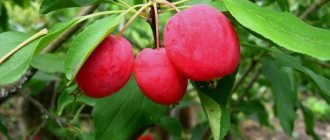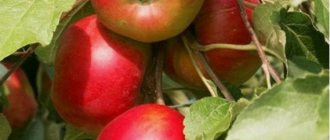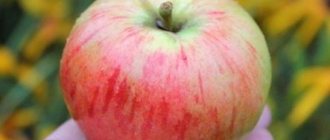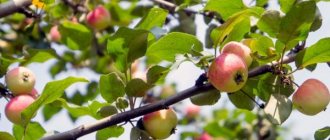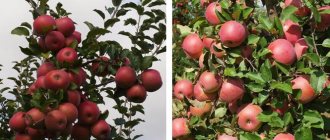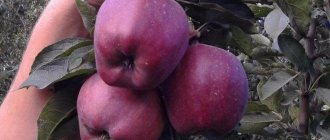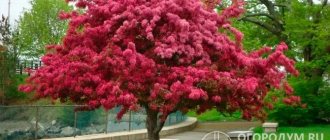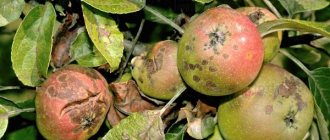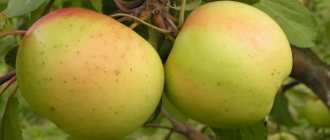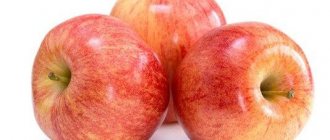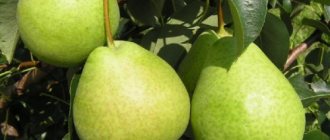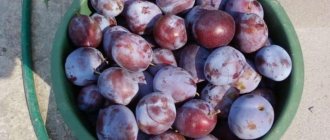Description, photo
The variety is young and promising ; it was developed at the oldest All-Russian Research Institute engaged in the selection of fruit crops.
Testing of the variety began in 1980, the first fruiting was obtained in 1991, in 1995 it was included in the elite , and the variety was released only in 2001.
Famous scientists and breeders have created a unique winter variety, which is characterized by high levels of winter hardiness, fruit quality and preservation, resistance to diseases and adverse environmental conditions.
The Stroevskoe variety was created in the natural conditions of the Moscow region , and became widespread throughout central Russia , as well as beyond its aisles in some regions of Belarus, Ukraine and the Baltic republics. It is most actively cultivated in the Oryol region.
additional characteristics
Advantages and disadvantages
It has practically no serious drawbacks . Only a rather long period before fruiting begins (5 - 8 years) can be disappointing, but over time the variety compensates for this with good yield and longevity of the tree. The plant is stable, unpretentious, responds well to watering and fertilizing. A mature tree requires minimal attention and care.
Dimensions of an adult tree
The variety belongs to medium-sized plants, has a wide, dense, pyramidal crown. The height of the trees on the rootstock is 3 - 4 meters . Apple tree varieties rarely grow above these sizes.
Apple tree Stroevskoe.
Important! The exception is trees on seed rootstock; they grow up to 5 meters.
Annual growth
The trees grow quite quickly and form a beautiful crown of medium density. The shoots have a faceted, arched, pronounced geniculate shape, medium thickness and are significantly pubescent.
Frequency of fruiting
During the period of testing and cultivation, the variety showed regular fruiting. Having entered fruiting late, apple trees bloom profusely every year and set fruit well.
Stroevskoe bears fruit regularly.
Productivity
The apples are of medium size, the weight of one is on average 110-130g, rarely the weight reaches 200g. A mature tree provides a yield of more than 50 kg per tree .
Tasting assessment
Apples of the Stroevskoye variety have a pleasant aroma, a sweet and sour taste, even more sweet than sour.
Sugar content not less than 9%. The pulp is dense, juicy, homogeneous, white, sometimes with a greenish tint. The content of ascorbic acid is not less than 8.7 mg/100g.
In terms of taste, the apples earned a rating of 4.4 points.
Fruits of the Stroevskoye apple tree.
After picking the fruits for one month, they are stored until they reach full consumer maturity. During long-term storage, apples do not lose their taste and juiciness.
Winter hardiness
When creating the variety, scientists focused on resistance to unfavorable conditions. As a result, the tree has high winter hardiness and can withstand harsh winters with temperatures up to 40 degrees below zero.
Disease resistance
Resistance to scab and other fungal diseases is inherent at the gene level (Vf gene) , obtained by open pollination through seed sowing (814).
Stroevskoe is resistant to scab.
Reviews
Alexander. “We had to wait a long time for apples. Only in the sixth year did some harvest appear. And now every year it blooms - a sight for sore eyes - and the harvest is excellent. No wonder we waited so long. Apples are stored in the basement until late spring and do not lose their taste.”
Natalia. “Time is dynamic, you want everything at once. I would like to plant an apple tree and have apples appear immediately. It won’t work out that way with Stroevsky, you have to wait. Personally, I am a supporter of such varieties. These are apple trees that will last for many years, reliable, strong and unpretentious.”
Michael. “The main advantages are excellent shelf life and presentation. And the transportability of apples is good. One of the best varieties for business. And if you choose seedlings on a low-growing rootstock, the costs will pay off quickly.”
Peter. “It’s good that the apple tree is winter-hardy. But will it have time to ripen in the north in the short summer?”
Michael. “The variety is, of course, late-ripening, but it will have time to ripen. It also helps that it ripens well during storage.”
Advantages and disadvantages
The plant has many positive characteristics, it is thanks to them that the Stroevskaya apple tree still remains popular.
Pros:
- High yield.
- Low maintenance requirements.
- Unpretentiousness.
- Stability of fruiting.
- Frost resistance.
- High immunity.
- Excellent fruit taste.
- Versatility of use and long shelf life of apples.
- Long fruiting period.
Minuses:
- You have to wait a very long time for the first fruits, 8-10 years.
Summer residents, knowing about this drawback of the apple tree, still buy it and plant it in the garden. Because the taste of apples and how long the plant then pleases with its fruits compensates for this minus.
Features of planting and care
Landing
Deadlines
It is important to observe the optimal timing for planting apple trees to ensure maximum plant survival:
- In spring, planting is carried out before the sap begins to flow: in late March - early April;
- In autumn, planting must be completed a month before the soil freezes. The best period for planting: late September - early October.
Watch the video on how to plant an apple tree in spring:
And a video on how to plant an apple tree in the fall:
Technology
The growth of the apple tree and, subsequently, its fruiting will depend on the quality of planting and planting material. Before planting, they are completely filled with organic and mineral fertilizers.
The planting hole is prepared in advance and the following is added to it:
- 2-3 buckets of humus or rotted manure;
- 50 - 60g of superphosphate, potassium sulfate and dolomite flour or wood ash.
All ingredients are thoroughly mixed with the fertile soil layer.
Planting pit preparation diagram.
The size of the hole should allow the roots to be freely positioned, while the root collar or grafting site should be located above the soil surface. The seedling is tied to a support and watered generously into the hole, preventing the roots from being washed out.
Distance
The planting scheme in the garden depends on the type of rootstock on which the seedlings are grown. For plants on a dwarf rootstock, a scheme of 2.5 x 4.0 m is suitable, for medium-sized plants - 3.5 x 5.0 m.
Distance when planting on different rootstocks.
Attention! Dense plantings impair the growth and development of trees, reduce yields and complicate plant care and harvesting.
Growing
The Stroevskoye apple tree variety, like other fruit trees in the garden, prefers fertile soil with good air exchange.
The close occurrence of groundwater will not contribute to the development of the root system; in waterlogged areas, plants may die.
Apple trees prefer well-lit areas protected from the wind. This is in ideal cases. But the variety is quite resistant and can be grown and bear fruit well in more difficult conditions.
Agricultural technology
Particular attention must be paid to young plants so that they develop a well-developed root system and adapt to the conditions.
In the first year of the apple tree’s life, it is necessary to regularly water it, loosen the soil between the rows, and destroy weeds. There is no need to fertilize in the first year; the plant uses the nutrients added during planting.
In regions with cold climates, it is necessary to mulch the tree trunk circles and insulate the tree trunk for the winter.
Insulate apple tree trunks for the winter.
In subsequent years:
- Watering during dry periods;
- Feeding in early spring and after flowering;
- Treatment against pests and diseases;
- Removing weeds, fallen leaves and fruits.
Watch the video on how and what to treat an apple tree against diseases and pests:
Pruning and crown formation
In the first year of life, the crown of the apple tree begins to form. The trunk of the annual tree is cut at a height of 70-90 cm to establish lateral branches.
In subsequent years, the side branches are left at a distance of 40-50 cm above each other, as if creating several tiers:
- Branches that are close to each other, intersecting and directed inward to the crown are cut out;
- The remaining branches are also cut off at the ends, which helps the crown grow wider.
Damaged shoots with signs of disease are removed using sanitary pruning.
Important! Pruning promotes crown rejuvenation.
Watch a video tutorial on pruning apple trees:
Pollinator varieties
To improve the fertilization of ovaries in the garden, the presence of other varieties of apple trees with coinciding flowering periods is necessary. The following are good pollinators for Stroevsky:
- Veteran;
- Memory of a warrior;
- Orlovsky Kandil.
Veteran.
Memory of a warrior.
Orlovsky Kandil.
Diseases and pests
Stroevskoe is an immune variety, i.e. it has immunity against some fungal diseases. For example, a tree is absolutely not susceptible to scab. But it can get sick with other diseases:
- powdery mildew - white coating, due to which the leaves curl and fall off; colloidal sulfur is used for treatment (80 g per 10 liters of water); prevention - spraying with sulfur solution in the spring when the first leaves appear, then after 14 days;
The first sign of powdery mildew is a whitish coating on the leaves and young shoots.
- moniliosis, or fruit rot, affecting fruits; method of struggle is to pick rotten apples from the tree and burn them; preventive measures - thinning pruning of branches for good lighting and ventilation of the tree and spraying 3 times with 1% Bordeaux mixture (1 - 3 days before flowering, 2 - when carrion appears, 3 - 14 days after the second spraying).
Moniliosis is a fungal disease to which the Stroevskoye variety has immunity, but it would be a good idea to prevent fruit rot
A big advantage of the Stroevskoye apple tree is its immunity to pests , which it copes with on its own. Therefore, preventive treatments are not necessary.
Features of ripening and fruiting
The variety is characterized by a mixed type of fruiting. Flower buds are formed both on the ringlets and on the fruit twigs. The stalks are short, of medium thickness, the apples stick well to the tree and are not prone to shedding.
Beginning of fruiting
begins to bear fruit relatively The first few fruits appear in the fourth or fifth year. Full fruiting begins in the seventh to ninth year of the plant’s life, and under unfavorable conditions even later.
Full fruiting of the apple tree begins at 7-9 years.
Deadlines
Blooms
Depending on the region and weather conditions, flowering periods range from the beginning to the third ten days of May.
Interesting! The variety is in no hurry to flower, so the first spring frosts can pass by without damaging the flowers and ovaries.
The inflorescences include 4-6 buds of white and pink color and the appearance of the flowering tree is completely unique.
Fruit ripening
Apples ripen by the end of September, and in order for them to achieve good consumer ripeness, it is better to keep them for another month.
Stroevskoe apples ripen by the end of September.
Fruit storage
The variety is very good for long-term storage. At favorable temperatures and humidity, apples fully retain their consumer and commercial qualities until the end of February, and in special refrigeration chambers until the end of spring.
Harvest and storage
Fruits must be carefully removed from the tree
The fruits of the varietal apple tree reach their full maturity at the end of September. For better storage, they should be kept on the tree for another 14-20 days.
The fruits should be picked carefully, trying not to damage them.
It is better to store apples in cardboard or wooden containers in one layer. The room in which the fruits will be located must have a stable cool temperature and low air humidity, and must also be periodically ventilated.
Fruits should be systematically inspected to detect damaged or spoiled specimens, which are immediately removed.
Apples are characterized by excellent keeping quality and retain their taste until the end of February - beginning of March. When using special closed containers, the fruits can be suitable for consumption until the beginning of summer.
Growing in regions
In the Moscow region and central Russia
The regions are the most favorable for growing the variety. Young plantings need watering, especially during dry periods. The trees tolerate winter well and respond to fertilizing.
Plants are grown as medium-sized plants or on dwarf rootstocks.
The height of the apple tree depends on the rootstock.
In Siberia
In particularly harsh regions of Siberia, it is difficult to grow large-fruited apple trees. To protect plants from freezing, it is necessary to mulch the soil above the root system, insulate the trunk, and form the crown extremely low above the ground so that it is completely covered with snow in harsh winters.
In the Urals
The winter hardiness of the variety allows it to be grown in the Urals. In cold, wet years, it is advisable to carry out preventive measures to combat fungal diseases.
For the winter, the trunk is insulated with spruce branches or covering material. This measure will protect the plant from damage by rodents.
The soil around the trunk circles is covered with rotted manure, sawdust or synthetic materials.
Planting a seedling on the site
Proper planting techniques will help you grow strong trees that will yield a rich harvest. By listening to the advice of experienced summer residents, even a beginner can grow an apple tree.
See also
What can a columnar apple tree be grafted onto and how to do it correctlyRead
Optimal timing
It is preferable to plant planting material in the spring, so the plant has more opportunity to take root and prepare for winter. Plant before sap flow begins. If a summer resident decides to plant in the fall, then it is necessary to choose the time so that the plants take root and begin to grow.
Required soil composition
Any fruit tree feels good on fertile soils. Stroevskoye prefers the following types of soil:
- sod-podzolic;
- gray forest soil;
- black soil
Other types of soil that are moderately acidic and slightly alkaline in composition are also suitable.
Landing scheme and technology
Heavily dense plantings have a bad effect on growth and fruiting, so it is necessary to maintain a distance of 3 m between trees. The pit is prepared in advance; humus and complex mineral fertilizers are first applied.
The seedling is placed in a planting hole and covered with soil so that the grafting site or root collar remains above the surface of the ground.
